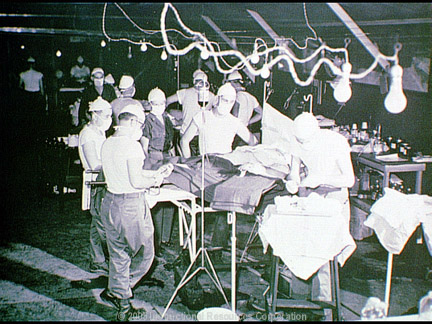Containing Communism in Korea
| Korean war: Canadian at first-aid station, 1951 | |||
|
|||
| Korean war: Canadian at first-aid station, 1951. IRC. 2005. Discovery Education. 15 February 2010 <http://streaming.discoveryeducation.com/> |
|||
| In the Korean War, a wounded Canadian rifleman is helped to a first-aid station, February 1951. The bulk of the military forces in Korea came from the U.S. and South Korea, but troops from 14 other nations fought there as well. |
North Korean aggression was quickly stifled upon UN entry into the Korean War in September 1950. After quickly pushing North Korean troops over the 38th parallel, UN Commander Douglas MacArthur received permission to pursue the North Koreans over the border in an effort to unite the two Koreas. This deviation from the original plan of containment broadened the war significantly by ultimately bringing the Chinese into the conflict. This decision proved fatal as the Chinese easily pushed the UN troops back over the 38th parallel. A stalemate ensued for the next 2 years until a ceasefire was finally declared in mid-1953.
 |
Review the information in the "Korean War" and "Korean War Aftermath" presentations below. As you read, complete 11.05 Korean War. Once finished, submit the work to the 11.05 Korean War Dropbox. Note: You do not have to review the "Revolution in China" or "Korean War Buildup" presentations for this assignment. |
| Map of southernmost advance, North Korean forces |
|||
 |
|
||
 |
|||
 |
|||
| Map of southernmost advance, North Korean forces. IRC. 2005. Discovery Education. 15 February 2010 <http://streaming.discoveryeducation.com/> |
|||
| A map of Korea showing the southernmost advance of North Korean forces, northernmost advance of UN forces, and the July 1953 truce line. |
| Chinese troops entering Korea in late 1950 | |||
 |
|
||
 |
|||
 |
|||
| Chinese troops entering Korea in late 1950.. IRC. 2005. Discovery Education. 15 February 2010 <http://streaming.discoveryeducation.com/> |
|||
| Chinese troops entering Korea in late 1950. The Korean War erupted in June, 1950, but only when U.S. troops had intervened in force, crossed the 38th parallel, and then approached the Chinese border did China decide to enter the war. Battle-hardened Chinese divisions led by Lin Biao quickly threw U.S. forces back below the 38th parallel in one of the most traumatic defeats in U.S. military history. |
| A M.A.S.H. unit | |||
 |
|
||
 |
|||
 |
|||
| A M.A.S.H. unit. IRC. 2005. Discovery Education. 15 February 2010 <http://streaming.discoveryeducation.com/> |
|||
| A Mobile Army Surgical Hospital (M.A.S.H.) during an operation, 20 miles from the front lines in Korea, August 1952. While diplomats disagreed, the armies continued to fight until 1953. |
Did you know that jet powered aircraft and helicopters were used heavily for the first time during the Korean War?



